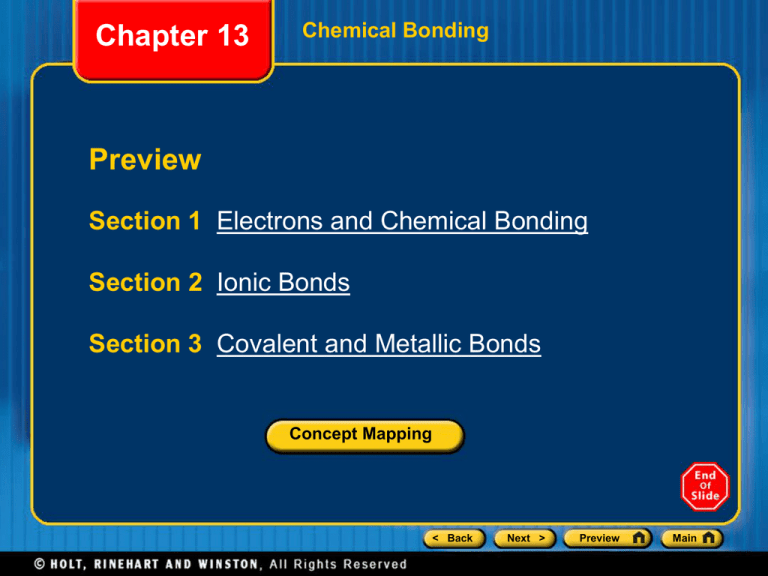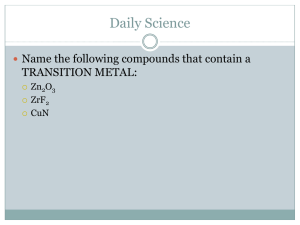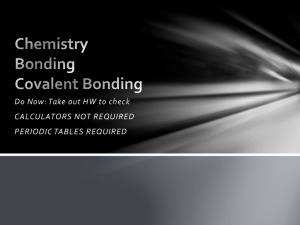Chemical Bonding
advertisement

Chapter 13 Chemical Bonding Preview Section 1 Electrons and Chemical Bonding Section 2 Ionic Bonds Section 3 Covalent and Metallic Bonds Concept Mapping < Back Next > Preview Main Chapter 13 Section 1 Electrons and Chemical Bonding Bellringer Look at these chemical formulas: C6H1206 C2H5OH C6H8O6 C6H8O7 Identify the elements in these compounds and predict whether the compounds are similar to each other. Explain your reasoning. < Back Next > Preview Main Chapter 13 Section 1 Electrons and Chemical Bonding Objectives • Describe chemical bonding. • Identify the number of valence electrons in an atom. • Predict whether an atom is likely to form bonds. < Back Next > Preview Main Chapter 13 Section 1 Electrons and Chemical Bonding Combining Atoms Through Chemical Bonding • Chemical bonding is the joining of atoms to form new substances. • An interaction that holds two atoms together is called a chemical bond. When chemical bonds form, electrons are shared, gained, or lost. < Back Next > Preview Main Chapter 13 Section 1 Electrons and Chemical Bonding Combining Atoms Through Chemical Bonding, continued • Discussing Bonding Using Theories and Models We cannot see atoms and chemical bonds with the unaided eye. • So, the use of models helps people discuss the theory of how and why atoms form bonds. < Back Next > Preview Main Chapter 13 Section 1 Electrons and Chemical Bonding Electron Number and Organization • The number of electrons in an atom can be determined from the atomic number of the element. • Electrons in an atom are organized in energy levels. • The next slide shows a model of the arrangement of electron in an atom. This model and models like it are useful for counting electrons, but do not show the true structure of an atom. < Back Next > Preview Main Chapter 13 Section 1 Electrons and Chemical Bonding < Back Next > Preview Main Chapter 13 Section 1 Electrons and Chemical Bonding Electron Number and Organization, continued • Outer-Level Electrons and Bonding Most atoms form bond using only its valence electrons, the electrons in an atom’s outermost energy level. < Back Next > Preview Main Chapter 13 Section 1 Electrons and Chemical Bonding Electron Number and Organization, continued • Valence Electrons and the Periodic Table You can use the periodic table to determine the number of valence electrons for atoms of some elements, as shown on the next slide. < Back Next > Preview Main Chapter 13 Section 1 Electrons and Chemical Bonding < Back Next > Preview Main Chapter 13 Section 1 Electrons and Chemical Bonding To Bond or Not to Bond • The number of electrons in the outermost energy level of an atom determine whether an atom will form bonds. • Atoms that have 8 electrons in their outermost energy level do not usually form bonds. The outermost energy level is considered to be full if it contains 8 electrons. < Back Next > Preview Main Chapter 13 Section 1 Electrons and Chemical Bonding To Bond or Not to Bond, continued • Filling the Outermost Level An atom that has fewer than 8 valence electrons is more likely to form bonds than at atom that has 8 valence electrons is. Atoms bond by gaining, losing, or sharing electrons to have a filled outermost energy level. < Back Next > Preview Main Chapter 13 Section 1 Electrons and Chemical Bonding To Bond or Not to Bond, continued • Is Two Electrons a Full Set? Not all atoms need 8 valence electrons to have a filled outermost energy level. Helium atoms need only 2 valence electrons because the outermost level is the first energy level. • Atoms of hydrogen and lithium form bonds by gaining, losing, or sharing electrons to achieve 2 electrons in the first energy level. < Back Next > Preview Main Chapter 13 Section 2 Ionic Bonds Bellringer Salts are ionic compounds. Brainstorm uses for salts, things that contain salts, and words and phrases containing the term salt. Write your responses in your science journal. < Back Next > Preview Main Chapter 13 Section 2 Ionic Bonds Objectives • Explain how ionic bonds form. • Describe how positive ions form. • Describe how negative ions form. • Explain why ionic compounds are neutral. < Back Next > Preview Main Chapter 13 Section 2 Ionic Bonds Forming Ionic Bonds • An ionic bond is a bond that forms when electrons are transferred from one atom to another atom. • Charged Particles An atom is neutral because the number of electrons in an atom equals the number of protons. So, the charges cancel each other out. • But when an atom gains or loses electrons, it becomes a charged particle called an ion. < Back Next > Preview Main Chapter 13 Section 2 Ionic Bonds Forming Positive Ions • Metal Atoms and the Loss of Electrons Atoms of most metals have few valence electrons and tend to lose these valence electrons and form positive ions. • The Energy Needed to Lose Electrons Energy is needed to pull electrons away from atoms. The energy needed comes from the formation of negative ions. < Back Next > Preview Main Chapter 13 Section 2 Ionic Bonds Forming Negative Ions • Nonmetal Atoms Gain Electrons The outer energy level of nonmetal atoms is almost full. So, nonmetal atoms tend to gain electrons and become negative ions. • The Energy of Gaining Electrons Energy is given off when nonmetals gain electrons. An ionic bond will form between a metal and a nonmetal if the nonmetal releases more energy than is needed to take electrons from the metal. < Back Next > Preview Main Chapter 13 Section 2 Ionic Bonds < Back Next > Preview Main Chapter 13 Section 2 Ionic Bonds Ionic Compounds • When ionic bonds form, the number of electrons lost by the metal atoms equals the number gained by the nonmetal atoms. • The ions that bond are charged, but the compound formed is neutral because the charges of the ions cancel each other. < Back Next > Preview Main Chapter 13 Section 2 Ionic Bonds Ionic Compounds, continued • When ions bond, they form a repeating threedimensional pattern called a crystal lattice, such as the one shown below. • Properties of ionic compounds include brittleness, high melting points, and high boiling points. < Back Next > Preview Main Chapter 13 Section 3 Covalent and Metallic Bonds Bellringer Take a minute or two to brainstorm a list of things made of metal. Then, use your list to describe three properties of metals. Write your responses in your science journal. < Back Next > Preview Main Chapter 13 Section 3 Covalent and Metallic Bonds Objectives • Explain how covalent bonds form. • Describe molecules. • Explain how metallic bonds form. • Describe the properties of metals. < Back Next > Preview Main Chapter 13 Section 3 Covalent and Metallic Bonds Covalent Bonds • A covalent bond forms when atoms share one or more pairs of electrons. • Substances that have covalent bonds tend to have low melting and boiling points and are brittle in the solid state. • Covalent bonds usually form between atoms of nonmetals, such as the atoms shown on the next slide. < Back Next > Preview Main Chapter 13 Section 3 Covalent and Metallic Bonds < Back Next > Preview Main Chapter 13 Section 3 Covalent and Metallic Bonds Covalent Bonds, continued • Covalent Bonds and Molecules Substances containing covalent bonds consist of particles called molecules. A molecule usually consists of two or more atoms joined in a definite ratio. • The models on the next slide show two ways to represent the covalent bonds in a water molecule. < Back Next > Preview Main Chapter 13 Section 3 Covalent and Metallic Bonds < Back Next > Preview Main Chapter 13 Section 3 Covalent and Metallic Bonds Covalent Bonds, continued • One way to represent atoms and molecules is to use electron-dot diagrams. An electron-dot diagram shows only the valence electrons in an atom. < Back Next > Preview Main Chapter 13 Section 3 Covalent and Metallic Bonds Covalent Compounds and Molecules • A molecule is the smallest particle into which a covalently bonded compound can be divided and still be the same compound. • The Simplest Molecules are made up of two bonded atoms. Molecules made up of two atoms of the same element are called diatomic molecules. < Back Next > Preview Main Chapter 13 Section 3 Covalent and Metallic Bonds Covalent Compounds and Molecules, continued • More-Complex Molecules Carbon atoms are the basis of many complex molecules. • Each carbon atom can form four covalent bonds. These bonds can be with atoms of other elements or with other carbon atoms, as shown at right. < Back Next > Preview Main Chapter 13 Section 3 Covalent and Metallic Bonds Metallic Bonds • A metallic bond is a bond formed by the attraction between positively charged metal ions and the electrons in the metal. • Movement of Electrons Throughout a Metal Bonding in metals is a result of the metal atoms being so close to one another that their outermost energy levels overlap. This overlapping allows valence electrons to move throughout the metal. < Back Next > Preview Main Chapter 13 Section 3 Covalent and Metallic Bonds Metallic Bonding Click below to watch the Visual Concept. Visual Concept < Back Next > Preview Main Chapter 13 Section 3 Covalent and Metallic Bonds Properties of Metals • Conducting Electric Current Metallic bonding allows metals to conduct electric current. • Electric current is conducted when valence electrons move within a metal. These electrons are free to move because the electrons are not connected to any one atom. < Back Next > Preview Main Chapter 13 Section 3 Covalent and Metallic Bonds Properties of Metals, continued • Reshaping Metals Because the electrons swim freely around the metal ions, atoms in metals can be rearranged. The properties of ductility and malleability describe a metal’s ability to be reshaped. • Ductility is the ability to be draw in to wires. • Malleability is the ability to be hammered into sheets. < Back Next > Preview Main Chapter 13 Section 3 Covalent and Metallic Bonds Properties of Metals, continued • Bending Without Breaking When a piece of metal is bent, some of the metal ions are forced closer together. • But the metal does not break because the positive metal ions are always surround by and attracted to the electrons in the metal. < Back Next > Preview Main Chapter 13 Chemical Bonding Concept Mapping Use the terms below to complete the Concept Mapping on the next slide. covalent bonds ions molecules electrons metallic bonds chemical bonds < Back Next > Preview Main Chapter 13 Chemical Bonding < Back Next > Preview Main Chapter 13 Chemical Bonding < Back Next > Preview Main








